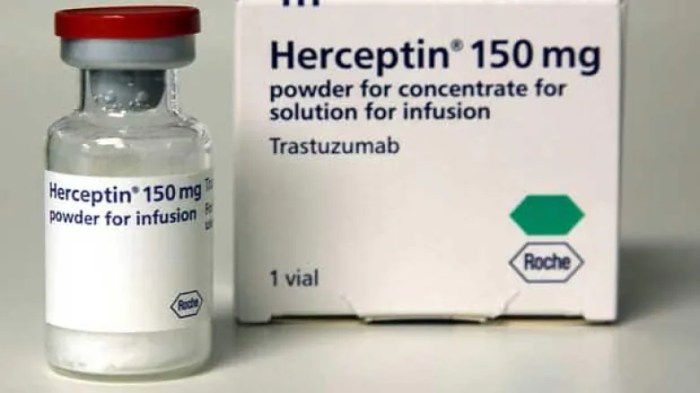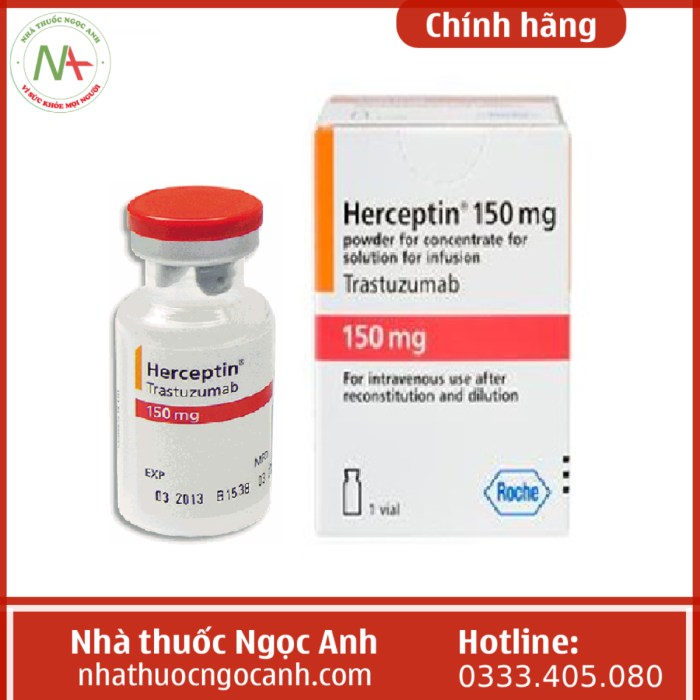Herceptin, also known as trastuzumab, is a groundbreaking targeted therapy that has revolutionized the treatment of HER2-positive cancers. This monoclonal antibody specifically targets the HER2 protein, which is overexpressed in certain types of cancer cells, leading to uncontrolled growth and spread. By binding to HER2, Herceptin blocks the signaling pathways that drive cancer cell proliferation, ultimately inhibiting tumor growth and potentially leading to remission.
The discovery of Herceptin was a significant milestone in cancer research, marking a shift towards personalized medicine. This targeted approach, rather than using traditional chemotherapy that affects all rapidly dividing cells, offers a more precise and effective treatment strategy for patients with HER2-positive cancers. Herceptin has become a standard of care for various cancers, including breast cancer, gastric cancer, and others, and continues to be a focus of ongoing research and development.
Herceptin

Herceptin, also known as trastuzumab, is a groundbreaking monoclonal antibody used in the treatment of certain types of cancer, primarily breast cancer. It works by targeting a protein called HER2, which is found on the surface of some cancer cells.
Mechanism of Action
Herceptin’s mechanism of action revolves around its ability to bind to the HER2 protein, effectively blocking its signaling pathways. HER2 is a receptor tyrosine kinase, and when it is overexpressed, it can promote uncontrolled cell growth and proliferation, leading to cancer development. By attaching to HER2, Herceptin prevents the receptor from activating downstream signaling pathways, ultimately inhibiting cancer cell growth and promoting apoptosis (programmed cell death).
Historical Development and Significance
The development of Herceptin was a significant milestone in cancer treatment. The discovery of the HER2 protein and its role in cancer development paved the way for the development of targeted therapies like Herceptin. Herceptin was first approved by the Food and Drug Administration (FDA) in 1998 for the treatment of metastatic breast cancer in patients with HER2-positive tumors. This marked a significant shift in cancer treatment, moving away from traditional chemotherapy towards more targeted approaches.
HER2-Positive Cancers

HER2-positive cancers are a type of cancer that overexpresses the human epidermal growth factor receptor 2 (HER2) protein. This overexpression can lead to uncontrolled cell growth and the development of aggressive tumors.
HER2-positive cancers are relatively common, accounting for about 20% of all breast cancers and a significant proportion of other cancers, including gastric, ovarian, and lung cancers.
HER2 Overexpression in Cancer Progression and Metastasis
HER2 overexpression plays a critical role in cancer progression and metastasis. It promotes tumor growth, angiogenesis (the formation of new blood vessels), and invasion into surrounding tissues. HER2 also contributes to the development of resistance to chemotherapy and other cancer treatments.
The overexpression of HER2 leads to the activation of signaling pathways that promote cell growth, proliferation, and survival. This uncontrolled growth can lead to the formation of tumors, which can then invade surrounding tissues and metastasize to other parts of the body.
Here’s how HER2 overexpression contributes to cancer progression and metastasis:
* Increased cell growth and proliferation: HER2 overexpression activates signaling pathways that promote cell growth and proliferation, leading to the formation of tumors.
* Angiogenesis: HER2 promotes the formation of new blood vessels, which supply tumors with nutrients and oxygen, enabling them to grow and spread.
* Invasion and metastasis: HER2 promotes the invasion of surrounding tissues and the spread of cancer cells to distant sites.
* Chemoresistance: HER2 overexpression can contribute to the development of resistance to chemotherapy and other cancer treatments.
The role of HER2 in cancer progression and metastasis highlights the importance of targeting HER2 in cancer treatment.
Herceptin Treatment Regimen
Herceptin, also known as trastuzumab, is a targeted therapy used to treat HER2-positive breast cancers and other cancers. It works by blocking the HER2 protein, which helps cancer cells grow and spread. Herceptin is typically administered in combination with chemotherapy drugs, and the specific treatment regimen depends on the type and stage of cancer.
Dosage and Administration
Herceptin is usually given as an intravenous (IV) infusion, typically over 90 minutes. The dosage of Herceptin depends on the patient’s weight and the type of cancer being treated.
Duration of Treatment
The duration of Herceptin therapy varies depending on the type of cancer and the patient’s response to treatment. In some cases, Herceptin may be given for a few months, while in other cases, it may be given for several years.
Treatment Cycles
Herceptin treatment is typically given in cycles, with each cycle lasting several weeks. The specific duration of each cycle depends on the type of cancer and the chemotherapy drugs being used.
Combination with Chemotherapy
Herceptin is often combined with chemotherapy drugs to improve the effectiveness of treatment. Some common chemotherapy drugs used in combination with Herceptin include:
* Paclitaxel (Taxol): A chemotherapy drug that targets microtubules, which are involved in cell division.
* Docetaxel (Taxotere): Another chemotherapy drug that targets microtubules.
* Anthracyclines (such as doxorubicin and epirubicin): Chemotherapy drugs that damage DNA.
* Fluorouracil (5-FU): A chemotherapy drug that blocks the production of DNA and RNA.
The combination of Herceptin with chemotherapy drugs can vary depending on the type and stage of cancer, the patient’s overall health, and other factors.
Effectiveness and Benefits of Herceptin

Herceptin, also known as trastuzumab, has proven to be a highly effective treatment for HER2-positive cancers, demonstrating significant improvements in patient outcomes. Numerous clinical trials have established its efficacy and benefits, leading to its widespread use in treating these types of cancers.
Clinical Trial Data Demonstrating Effectiveness
Clinical trials have provided compelling evidence of Herceptin’s effectiveness in treating HER2-positive cancers. These trials have evaluated the drug’s impact on various aspects of the disease, including tumor response, survival rates, and quality of life.
- One pivotal study, the Herceptin Adjuvant (HERA) trial, involved over 5,000 patients with early-stage HER2-positive breast cancer. The study demonstrated that Herceptin, when used in combination with standard chemotherapy, significantly reduced the risk of disease recurrence and improved overall survival. Patients who received Herceptin had a 37% reduction in the risk of breast cancer recurrence compared to those who received chemotherapy alone. This reduction in recurrence risk translated into a significant improvement in overall survival, with a 24% reduction in the risk of death from breast cancer.
- Another landmark study, the National Surgical Adjuvant Breast and Bowel Project (NSABP) B-31 trial, also demonstrated the effectiveness of Herceptin in treating HER2-positive breast cancer. This trial, involving over 4,000 patients, found that Herceptin, when used in combination with chemotherapy, significantly improved disease-free survival, the time period during which patients remain free of cancer. The study showed that Herceptin significantly reduced the risk of breast cancer recurrence by 52% compared to chemotherapy alone.
- These studies and others have consistently demonstrated the efficacy of Herceptin in treating HER2-positive breast cancer, leading to its widespread adoption as a standard of care for this type of cancer.
Survival Rates and Response Rates
Herceptin has significantly improved survival rates and response rates in patients with HER2-positive cancers.
- In early-stage HER2-positive breast cancer, Herceptin has been shown to increase overall survival by several years. For example, in the HERA trial, patients who received Herceptin had a median overall survival of 12.6 years compared to 9.5 years for those who received chemotherapy alone. This significant improvement in overall survival highlights the impact of Herceptin on the long-term outcomes of patients with this type of cancer.
- Herceptin has also been shown to significantly improve response rates in patients with HER2-positive cancers. Response rates refer to the percentage of patients who experience a reduction in tumor size or a complete disappearance of the tumor. In clinical trials, Herceptin has been shown to achieve response rates of over 50% in patients with HER2-positive breast cancer. This high response rate underscores the effectiveness of Herceptin in targeting and destroying cancer cells.
Potential Benefits of Herceptin
Herceptin offers several potential benefits for patients with HER2-positive cancers, including:
- Tumor Shrinkage: Herceptin has been shown to effectively shrink tumors in many patients with HER2-positive cancers. This tumor shrinkage can lead to a reduction in symptoms and an improvement in quality of life.
- Improved Overall Survival: As mentioned earlier, Herceptin has been shown to significantly improve overall survival in patients with HER2-positive cancers. This means that patients who receive Herceptin are more likely to live longer than those who do not.
- Disease-Free Survival: Herceptin has also been shown to improve disease-free survival, the time period during which patients remain free of cancer. This benefit is particularly important for patients with early-stage cancer, as it helps to prevent the recurrence of the disease.
- Improved Quality of Life: Herceptin can help to improve quality of life for patients with HER2-positive cancers. By shrinking tumors and preventing recurrence, Herceptin can reduce symptoms, improve physical function, and allow patients to live more fulfilling lives.
Side Effects and Risks of Herceptin
While Herceptin offers significant benefits for HER2-positive cancers, it’s crucial to understand the potential side effects and risks associated with its use. Like many cancer treatments, Herceptin can cause a range of side effects, some of which may be serious.
Common Side Effects
Common side effects of Herceptin are generally mild to moderate and often improve over time.
- Nausea and Vomiting: This is a common side effect, and anti-nausea medications can help manage it.
- Diarrhea: This can be treated with medication and dietary adjustments.
- Fatigue: Feeling tired is a common side effect of cancer treatment, and getting adequate rest is important.
- Rash or Skin Reactions: Herceptin can sometimes cause a rash or skin irritation at the injection site.
- Joint Pain: This is a less common side effect, but it can be managed with pain relievers and physical therapy.
Serious Side Effects
While less common, Herceptin can also cause serious side effects that require immediate medical attention.
- Cardiotoxicity: Herceptin can potentially damage the heart, leading to heart failure. This risk is higher in patients with pre-existing heart conditions. Regular heart monitoring is crucial during Herceptin therapy.
- Infusion Reactions: Some patients may experience allergic reactions during Herceptin infusions, including fever, chills, and difficulty breathing. Pre-medication with antihistamines and steroids can help prevent or minimize these reactions.
- Lung Problems: Herceptin can rarely cause lung problems, such as shortness of breath or pneumonia.
- Liver Problems: Herceptin can sometimes affect liver function, and regular liver function tests are necessary during treatment.
Managing Side Effects and Minimizing Risks, Herceptin
Your doctor will closely monitor you for any side effects during Herceptin therapy.
- Early Detection and Management: Prompt reporting of any side effects to your doctor is essential for early detection and management.
- Medication: Medications can be used to manage many side effects, such as nausea, diarrhea, and joint pain.
- Lifestyle Changes: Dietary adjustments, adequate rest, and staying hydrated can help manage some side effects.
- Heart Monitoring: Regular heart monitoring, including echocardiograms, is essential to assess for any heart damage.
- Pre-medication: Pre-medication with antihistamines and steroids can help prevent or minimize infusion reactions.
Herceptin represents a powerful example of the progress made in cancer treatment. By targeting specific proteins like HER2, researchers are developing more effective and less toxic therapies. As our understanding of cancer biology continues to evolve, personalized medicine approaches like Herceptin hold immense promise for improving patient outcomes and enhancing the quality of life for individuals battling these challenging diseases.
Herceptin, a targeted therapy for breast cancer, works by blocking the HER2 protein, which can cause cancer cells to grow and spread. While Herceptin focuses on the cellular level, other medications like terbutaline sulphate target different bodily systems, such as the respiratory system. Understanding the diverse mechanisms of action of these medications allows for personalized treatment plans and better management of various conditions.